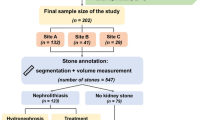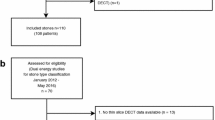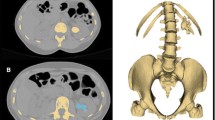Abstract
The aim of this study was to evaluate the efficacy of helical CT using a combination of CT-attenuation values and visual assessment of stone density as well as discriminant linear analysis to predict the chemical composition of urinary calculi. One hundred human urinary calculi were obtained from a stone-analysis laboratory and placed in 20 excised pig kidneys. They were scanned at 80, 120 and 140 kV with 3-mm collimation. Average, highest and lowest CT-attenuation values and CT variability were recorded. The internal calculus structure was assessed using a wide window setting, and visual assessment of stone density was recorded. A stepwise discriminant linear analysis was performed. The following three variables were discriminant: highest CT-attenuation value, visual density, and highest CT-attenuation value/area ratio, all at 80 kV. The probability of correctly classifying stone composition with these three variables was 0.64, ranging from 0.54 for mixed calculi to 0.69 for pure calculi. The probabilities of correctly classifying calculus composition were: 0.91 for calcium oxalate monohydrate and brushite, 0.89 for cystine, 0.85 for uric acid, 0.11 for calcium oxalate dihydrate, 0.10 for hydroxyapatite, and 0.07 for struvite calculi. When the first two ranks of highest probability for the accurate classification of each calculus type were taken into account, 81% of the calculi were correctly classified. Assessment at 80 kV of the highest CT-attenuation value, visual density and the highest CT-attenuation value/area ratio accurately predicts the chemical composition of 64–81% of urinary calculi. When the first two ranks of highest probability for the accurate classification of each calculus type were taken into account, all cystine, calcium oxalate monohydrate and brushite calculi were correctly classified.

Similar content being viewed by others
References
Renner C, Rassweiler J (1999) Treatment of renal stones by extracorporeal shock wave lithotripsy. Nephron 81[Suppl 1]:71–81
Dretler SP (1994) Special article: calculus breakability—fragility and durility. J Endourol 8:1–3
Logarakis NF, Jewett MA, Luymes J et al (2000) Variation in clinical outcome following shock wave lithotripsy. J Urol 163:721–725
Miller OF, Rineer SK, Reicherd SR et al (1998) Prospective comparison of unenhanced helical computed tomography and intravenous urography in the evaluation of acute flank pain. Urology 52:982–987
Boulay I, Holtz P, Foley WD, White B, Begun FP (1999) Ureteral calculi: diagnostic efficacy of helical CT and implications for treatment of patients. Am J Roentgenol 172:1485–1490
Sourtzis S, Thibeau JF, Damry N, Raslan A, Vandendris M, Bellemans M (1999) Radiologic investigation of renal colic: unenhanced helical CT compared with excretory urography. Am J Roentgenol 172:1491–1494
Yilmaz S, Sindel T, Arslan G et al (1998) Renal colic: comparison of spiral CT, US and IVU in the detection of ureteral calculi. Eur Radiol 8:212–217
Ripolles T, Agramunt M, Errando J, Martinez MJ, Coronel B, Morales M (2004) Suspected ureteral colic: plain film and sonography vs unenhanced helical CT. A prospective study in 66 patients. Eur Radiol 14:129–136
Preminger GM, Vieweg J, Leder RA, Nelson RC (1998) Urolithiasis: detection and management with unenhanced spiral CT—a urologic perspective. Radiology 207:308–309
Nakada SY, Hoff DG, Attai S, Heisey D, Blankenbaker D, Pozniak M (2000) Determination of stone composition by noncontrast spiral computed tomography in the clinical setting. Urology 55:816–819
Motley G, Dalrymple N, Keesling C, Fischer J, Harmon W (2001) Hounsfield unit density in the determination of urinary stone composition. Urology 58:170–173
Herremans D, Vandeursen H, Pittomvils G et al (1993) In vitro analysis of urinary calculi: type differentiation using computed tomography and bone densitometry. Br J Urol 72:544–548
Newhouse JH, Prien EL, Amis ES, Dretler SP, Pfister RC (1984) Computed tomographic analysis of urinary calculi. Am J Roentgenol 142:545–548
Saw KC, McAteer JA, Monga AG, Chua GT, Lingeman JE, Williams JC Jr (2000) Helical CT of urinary calculi: effect of stone composition, stone size, and scan collimation. Am J Roentgenol 175:329–332
Tellez Marinez-Fornes M, Burgos Revilla FJ, Saez Garrido JC et al (1997) In vitro study with techniques of imaging of the composition of urinary calculi. Actas Urol Esp 21:89–99
Hillman P, Gaines BJ, Drach GW, Tracey JA (1984) Computed tomographic analysis of renal calculi. Am J Roentgenol 142:549–552
Burgos FJ, Sanchez J, Avila S, Saez JC, Escudero Barrilero A (1993) The usefulness of computerized axial tomography (CT) in establishing the composition of calculi. Arch Esp Urol 46:383–391
Mostafavi MR, Ernst RD, Saltzman B (1998) Accurate determination of chemical composition of urinary calculi by spiral computerized tomography. J Urol 159:673–675
Williams JC, Paterson RF, Kopecky KK, Lingeman JE, McAteer JA (2001) High resolution detection of internal structure of renal calculi by helical computerized tomography. J Urol 167:322–326
Liu W, Esler SJ, Kenny BJ, Goh RH, Rainbow AJ, Stevenson GW (2000) Low-dose nonenhanced helical CT of renal colic: assessment of ureteric stone detection and measurement of effective dose equivalent. Radiology 215:51–54
Dalrymple NC, Verga M, Anderson KR et al (1998) The value of unenhanced helical computerized tomography in the management of acute flank pain. J Urol 159:735–740
Rassweiler JJ, Renner C, Chaussy C, Thuroff S (2001) Treatment of renal stones by extracorporeal shockwave lithotripsy: an update. Eur Urol 39:187–199
Rassweiler JJ, Körhrmann KU, Seemann O et al (1996) Clinical comparison of EWSL. In: Coe FL, Favus MJ, Pak CYC et al (eds) Kidney stones: medical and surgical management. Lippincott-Raven, Philadelphia, p 571
Parienty RA, Ducellier R, Pradel J, Lubrano J-M, Coquille F, Richard F (1982) Diagnostic value of CT numbers in pelvocalyceal filling defects. Radiology 145:743–747
Tublin ME, Murphy ME, Delong DM, Tessler FN, Kliewer MA (2002) Conspicuity of renal calculi at unenhanced CT: effects of calculus size and CT technique. Radiology 225:91–96
Levi C, Gray JE, McCullough EC, Hattery RR (1982) The unreliability of CT numbers as absolute values. Am J Roentgenol 139:443–447
Author information
Authors and Affiliations
Corresponding author
Rights and permissions
About this article
Cite this article
Bellin, MF., Renard-Penna, R., Conort, P. et al. Helical CT evaluation of the chemical composition of urinary tract calculi with a discriminant analysis of CT-attenuation values and density. Eur Radiol 14, 2134–2140 (2004). https://doi.org/10.1007/s00330-004-2365-6
Received:
Revised:
Accepted:
Published:
Issue Date:
DOI: https://doi.org/10.1007/s00330-004-2365-6




